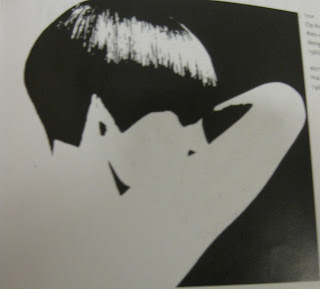 |
| Ossie wears one of his silk crepe shirts with a one side collar and a jumper knitted by his mother. |
I have decided after looking through the magazines and our presentation on the 1960’s to look into one of the designers in more depth from this era rather than a modern one as this would be more in keeping into what we have already been working on. I have got my resources from the internet and books, all the images are from a book created by Judith Watt.
Ossie Clark really named Raymond, was an amazing designer whom in his productive years coincided with London's most optimistic, rule breaking period.Born in Liverpool, when studying in London he was singled out by Vogue in their 1965 issue at just the age of 23 studying at Royal College of Art, this in it's self marked the kind of designer he was thought to be.
His work is particularly known for his real understanding of the female form. His tailoring skills were apparent in all of his works, and his work was thought to look effortless. Wether he was working with materials such as suede, leather or lighter weight fabrics such as wool, chiffon and silks which became his signature pieces, due to how effortlessly elegant and sophisticated the outcomes looked, but above all his clothes were feminine.
 |
| Twiggy models one of Ossie's chiffon dresses. |
Ossie Clark was the first young British designer's work to be exported to New York. Ossie Clark took influence from nature: trees, flowers, the moon, stars, colour and natural forms, this all excited him and his aim was to create beauty in his work. The brilliance behind his work lay in his ability to understand form and proportion and achieve it through cut and fabric.
 |
| Celia's Drawing 1969 |
 |
| Cream silk chiffon blouse with a combination of patterns. 1969 |
Ossie Clark’s big success came when he collaborated with textile designer Ceila Birtwell in 1965, whom later became his wife. Celia’s work was based around bold busy prints that complimented Ossie Clark’s sophisticated clean cut style to tailoring. Their collections were just up the the young fashion conscious youths of the 1960’s street, keeping the designs in trend but with an innovative twist.
 |
| Ossie with Chrissie Shirmpton, who wears his quilted coat in Robert Indiana Op-Art fabric. 1965 |
 |
| Ossie's fashion drawing for the coat above. |
Ossie Clark's idol was the famous dancer Nijinsky and his love of dance inspired his clothes to be free moving and not to restrict the female form. This style of dressing became quite popular in the 1970’s thanks in large part to the popularity of Clark's clothing. Ossie Clark is well known for his use of muted colours and moss crepe fabric. He also designed shoes, paper dresses, and snakeskin jackets.
 |
Cream chiffon dress with purple floral print, 1970.
Collection of Alfrend Radley |
 |
Cream rayon crepe dress and coat with a red and black flower print. 1970.
|
 |
| Another Celia Drawing. 1970 |
He quickly began to make his mark in the fashion industry after graduation from London’s Royal College of Art, with Alice Pollock's exclusive boutique Quorum featuring his designs in 1966. Ossie presented a collection of white and cream chiffon garments that sold fast.
Radely took over Quorum's debts, after the love of the work and not for business took it tole. Alfred Radley was keen to maintain what made Ossie special and so he continued to support Ossie's aspirations by developing the Ossie Clark Brand and funding large annual fashion shows, expanding Quorum's retail business and distributing Ossie's dresses to leading retailers around the world, this was the beginning of making the Ossie Clark brand available to thousands of ordinary people.
Over the year’s Ossie Clark’s creations have earned him some renowned clients such as: Twiggy, Penelope Tree, Marianne Faithfull, Talitha Getty, Bianca Jagger, Jean Shrimpton, Elizabeth Taylor and Liza Minnelli, whom all would attend his theatrical events. His friendships were very influential and did a lot for his brand.
Going into the 1980s, Ossie Clark's romantic flowing gowns were no longer in fashion. His fortunes declined to bankruptcy and Ossie Clark largely stopped working commercially. His bitterness at this and a short-sighted determination to sit out the bankruptcy term, meant he worked only on private commissions which were paid for by barter. A loyal band of famous clients and friends would order a dress and pay for it by loaning a holiday house in the Caribbean or paying for his sewing machine to be repaired.
After a low in his carrier due to the mixture of relationships and drugs. He made a come back in the early 1990s he trained the designer Bella Freud to pattern-cut and an extremely promising new beginning was the use of Clark's mastery of pattern cutting chiffon and delicate fabrics by the Ghost label. Clark found their computerised pattern cutter a revelation, able to turn initial ideas into formers almost instantaneously.














































